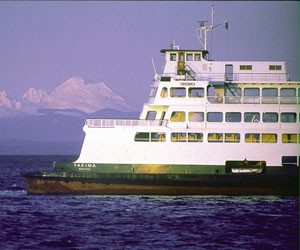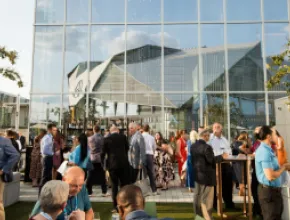As far as reputations go, the Seattle area has long been a city of epic and omnipresent icons: the Space Needle, Microsoft, Boeing, Mount Rainier, Starbucks, Amazon. Throw in major draws like the stunning Puget Sound, Pike Place Market, a booming culinary and arts scene, and being the launching pad for Alaska cruises, and it is surprising how many Americans have yet to experience the "Emerald City."
For planners of both corporate and association groups, however, this pervading newness is proving a major boon in drawing attendees to the Northwest and raising the level of enthusiasm. And with impressive changes in downtown Seattle and adjacent Bellevue, those who knew the area just a few years ago are in for an entirely new experience.
With many of the country’s pricier destinations still struggling to attract meetings business in this economy, Seattle is finding it hits a sweet spot: big-city amenities and appeal, yet with noticeable savings compared to many other top destinations. And even lower prices can be found in its neighboring cities, such as Tacoma to the south and the small communities in-between.
So while the Seattle area has long been a gem for those who know it, the combination of its newly polished surface and relative affordability are making it a life-saver for planners under budgetary constraints.
Seattle
Bordered by two mountain ranges, several iconic peaks, large forested state and national parks, and the Puget Sound, Seattle has forever been an outdoor lover’s city. For visitors, this enthusiasm for nature and outdoor recreation can be seen almost everywhere, from the North Face-clad locals and hardcore bicycle commuters to the natural elements of public spaces and meeting venues. This might seem odd for a city maligned by its reputation for soggy weather, but Seattle and its denizens have learned to work around this.
"Don’t be dissuaded by the rumors of rainy weather; the city and its facilities more than compensate for the occasional shower," says Dan Steighner, director of meetings management for TMS, a professional engineering materials association. Steighner brought 3,446 attendees from more than 70 countries to Seattle in February for the TMS 2010 Annual Meeting & Exhibition.
Aside from Seattle’s aesthetic appeal, he chose the location for the considerable convenience and accessibility the city provided, the array of meeting space available at the convention center, the convenience of the hotels, the number of domestic and international flights available at Sea-Tac International Airport, the walkability of its downtown area and the plethora of nearby dining, entertainment and shopping options.
Adding to this tight downtown package, a new Four Seasons and Hyatt recently opened, and the Washington State Convention Center is adding a new high-end conference center this summer that will expand the venue’s total meeting space to 276,000 square feet.
In tandem with the growth in infrastructure, the city has a lot more diversions for all the extra attendees it can host, in particular the art scene. This fall, for example, a new Picasso Masterpiece exhibit will open at the Seattle Art Museum, a popular venue for private events. And the Experience Music Project, an innovative Frank Gehry-designed music museum with multiple buyout and event options, recently opened several new exhibits.
Two other new group options come from local DMC Evergreen Escapes: A "vampire country" tour to the mystical forests of the Olympic Peninsula, which inspired the best-selling Twilight book series, and a new voluntourism program that involves habitat restoration of the Seattle area’s natural parks.
With so much to do, both within the city and abroad, planners discover their attendees have a high interest in making the most out of their Seattle stay.
"Planners are surprised at the interest in pre- and post-," says Jerri Lane, senior vice president of sales and marketing of Seattle’s CVB. "People often stay an extra few days. And we are still a fresh destination; many people have not been here. Planners will have their all-time high in attendance here."
Bellevue
With more than 20 building cranes running at the same time in 2007, Bellevue, just 20 minutes east of Seattle, has experienced an unprecedented boom that has transformed the small city from a sleepy business park to a high-end destination. Thanks to a new Microsoft branch and a surging meetings market, the small, walkable downtown has drawn an impressive collection of high-end dining, shopping, entertainment and hotel options, nearly all of which are tailor-made for corporate business and meetings.
"Bellevue is a modern, new, metropolitan city with all of the amenities that meeting planners and attendees desire," says Sharon Linton, marketing and communications manager for Bellevue Washington Conventions. "The residential population has blossomed as well, more than doubling in the past few years, and more growth is expected. This adds to the vibrancy of the area as more residents, employees and visitors fill the sidewalks and plazas."
For such a relatively small city, the state-of-the-art Meydenbauer Center is more than a pleasant surprise. With 54,000 square feet of meeting space, an attached theater and 2,400 hotel rooms within walking distance, it has opened the eyes of more than a few planners, who realize that adjacent Seattle is now more of a fringe benefit than a necessity.
Conveniently situated right across the street is the Courtyard by Marriott, with 253 guest rooms. Just a few blocks away is the newly renovated, 733-room Hyatt Regency, with a whopping 60,000 square feet of meeting space, and a Hilton, with 353 guest rooms and 22,000 square feet of meeting space. A Westin offers 337 guest rooms and 25,710 square feet of function space.
As shiny and new as Bellevue’s hotel package is, however, the latest and greatest are the city’s high-end restaurants with private event space, bars and lounges available for private functions and meetings, and the high-end commercial experience that is The Shops at The Bravern. Located adjacent to the Meydenbauer Center, The Bravern features the only Neiman Marcus north of San Francisco, Salvatore Ferragamo, Louis Vuitton and Hermes, and several fine-dining options.
Seattle Southside/SeaTac
With the convenience of Sea-Tac International Airport, the proximity to both Tacoma and Seattle, and the considerable savings it offers, the region of Seattle Southside has major appeal for planners seeking a bargain.
The sheer number of hotels that surround Sea-Tac (9,000 rooms in the Southside area) gives planners a tremendous range of options and purchasing power. The Hilton Seattle Airport & Conference Center, for example, offers 396 guest rooms and 24,000 square feet of meeting space, while the Doubletree Hotel Seattle Airport provides 850 guest rooms and 30 meeting spaces.
For larger events, the brand-new ShoWare Center opened just last year under Gold LEED specifications and can offer space for events and trade shows with more than 6,000 attendees.
Meanwhile, the Cedarbrook Lodge is only five minutes from the airport, yet insulated by 18 acres of natural wetlands. It offers numerous indoor and outdoor meeting options, along with 102 guest rooms.
When it comes time for team building and unique off-site events, the Museum of Flight and the Family Fun Center offer affordable and entertaining group options.
Tacoma
As the second half of the "Sea-Tac" airport equation, Tacoma is Seattle’s lesser-known twin at the south end of the Puget Sound. Yet while historically given short shrift as the more industrial city, over the last decade Tacoma has invested considerably in its downtown and today is brimming with trendy restaurants, unique museums, chic art galleries and smart hotels.
"Tacoma has a vibrant, glass-inspired downtown core that’s alive with museums, restaurants and a beautiful waterfront," says Shauna Lunde, director of sales and marketing of the Tacoma Regional CVB. "Tacoma is smaller than Seattle but it has all the urban amenities and cultural opportunities of a larger city. A great example of this is the fact that there are three museums located in a pedestrian-friendly triangle that conference delegates can easily access by foot or via the Link Light Rail from their hotel or the convention center."
For larger meetings, Tacoma has an enviable package. The Greater Tacoma Convention and Trade Center offers 21 meeting rooms and 51,000 square feet of exhibition space, while the adjacent Hotel Murano and Courtyard by Marriott offer a nice split between price tiers and a combined 481 guest rooms.
Off-site meetings are where Tacoma really shines. The Point Defiance Park Zoo and adjacent Japanese Gardens and Rose Gardens are long-standing favorites, while indoor options like the Museum of Glass and Tacoma Art Museum are engaging choices for potentially inclement weather. For smaller groups looking for an interactive or team-building experience, the CVB can recommend a number of local artists and galleries that work with groups, such as the popular Tacoma Glassblowing Studio. For gaming fun, the Emerald Queen Casino is as close as it gets to Vegas.
Snohomish County
With recent investment in the meetings market and a longstanding reputation for outdoor recreation and nature, Snohomish County, just north of Seattle, has major appeal for planners with small to midsize groups looking to capitalize on affordable rates and more of a retreat feel than the bigger cities to the south. Yet despite this, the county is only 20 miles north of Seattle, so trips into the city for events or dinner are relatively quick and easy.
The modern Lynwood Convention Center, built just five years ago, provides 34,000 square feet of meeting space, while the Edward D. Hansen Conference Center offers 12,000 square feet.
For alternative options, the Future of Flight Aviation Center can seat up to 750 for a memorable reception. The Manor, an upscale venue with 4,500 square feet of space and beautiful landscaping, is an ideal option for private, secluded events.
Hunter Holcombe is a freelance writer who covers leisure travel and the meetings, conventions and incentives industry.






